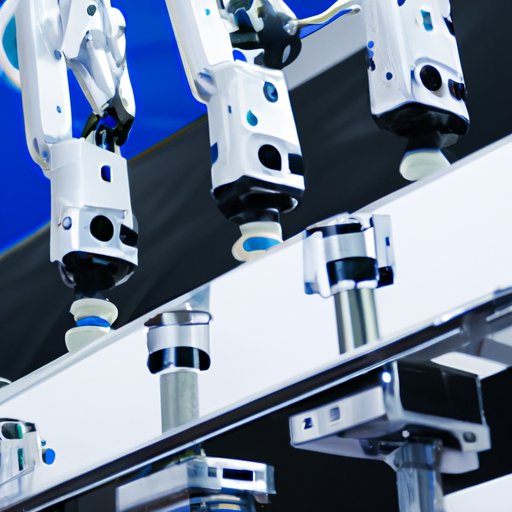Introduction
Robotics is the science of designing, constructing, and operating machines to perform specific tasks. In recent years, robotics has become increasingly popular in industrial settings as a means of automating various processes. This article will explore how robots are used in factories and examine the benefits of automation in manufacturing.

Examining the Impact of Robotics on Factory Production
Robots can be used in a variety of ways to improve the efficiency and speed of factory production. For example, robots can be programmed to perform repetitive tasks quickly and accurately, freeing up workers to focus on more complex tasks. Additionally, robots can be used to automate the movement of materials throughout the factory, reducing the need for manual labor.
Robots can also improve safety in the workplace. By taking over hazardous or difficult tasks, robots can reduce the risk of injury to workers. Furthermore, robots can be programmed to work in areas that would otherwise be too dangerous for humans, such as environments with high temperatures or exposure to toxic chemicals.
Finally, robots can be used to handle complex tasks that require precise coordination and control. By programming robots to complete intricate tasks, factories can ensure that their products are of the highest quality.
Investigating the Role of Robotics in Quality Control
Robots can play an important role in maintaining quality control in factories. By using robots to perform repetitive tasks, factories can ensure that their products are consistently accurate and of the highest quality. Additionally, robots can be used to monitor the production process and detect any potential problems before they become serious issues.
Robots can also help reduce human error, which can lead to costly mistakes. By automating certain processes, robots can eliminate the possibility of human error and ensure that each product meets the desired specifications. Furthermore, robots can be used to inspect finished products and identify any defects or inconsistencies.
Finally, robots can help improve productivity in factories by performing tasks faster and more efficiently than humans. This can help factories reduce costs and increase profits.

Analyzing How Robots Are Used in Factory Logistics
Robots can be used to automate various processes within factory logistics. For example, robots can be used to transport materials from one location to another, reducing the need for manual labor. Additionally, robots can be used to automate the storage and retrieval of materials, eliminating the need for human intervention.
Robots can also be used for robotic assembly and disassembly. By programming robots to assemble and disassemble components, factories can reduce the need for manual labor and improve the accuracy of the assembly process.
Evaluating the Cost-Savings of Robot Implementation in Factories
The implementation of robots in factories can provide numerous cost-savings. For example, robots can help reduce labor costs by performing tasks more quickly and efficiently than humans. Additionally, robots can help reduce energy consumption by performing tasks that require less energy than manual labor.
Robots can also help reduce maintenance costs by reducing the need for frequent repairs and replacements. Additionally, robots can help reduce the amount of waste generated by factories by ensuring that products are produced accurately and efficiently.
Conclusion
Robots can provide numerous benefits to factories, including increased efficiency and speed, improved safety, the ability to handle complex tasks, enhanced accuracy and consistency, reduced human error, improved productivity, lower labor costs, reduced energy consumption and lower maintenance costs. As the technology continues to advance, robots will become even more integral to the manufacturing process.
In conclusion, robots can be used to automate various processes in factories and provide numerous cost-savings. In order to maximize the benefits of robot implementation in factories, it is important for factories to invest in the latest technology and ensure that robots are properly programmed and maintained.
(Note: Is this article not meeting your expectations? Do you have knowledge or insights to share? Unlock new opportunities and expand your reach by joining our authors team. Click Registration to join us and share your expertise with our readers.)
